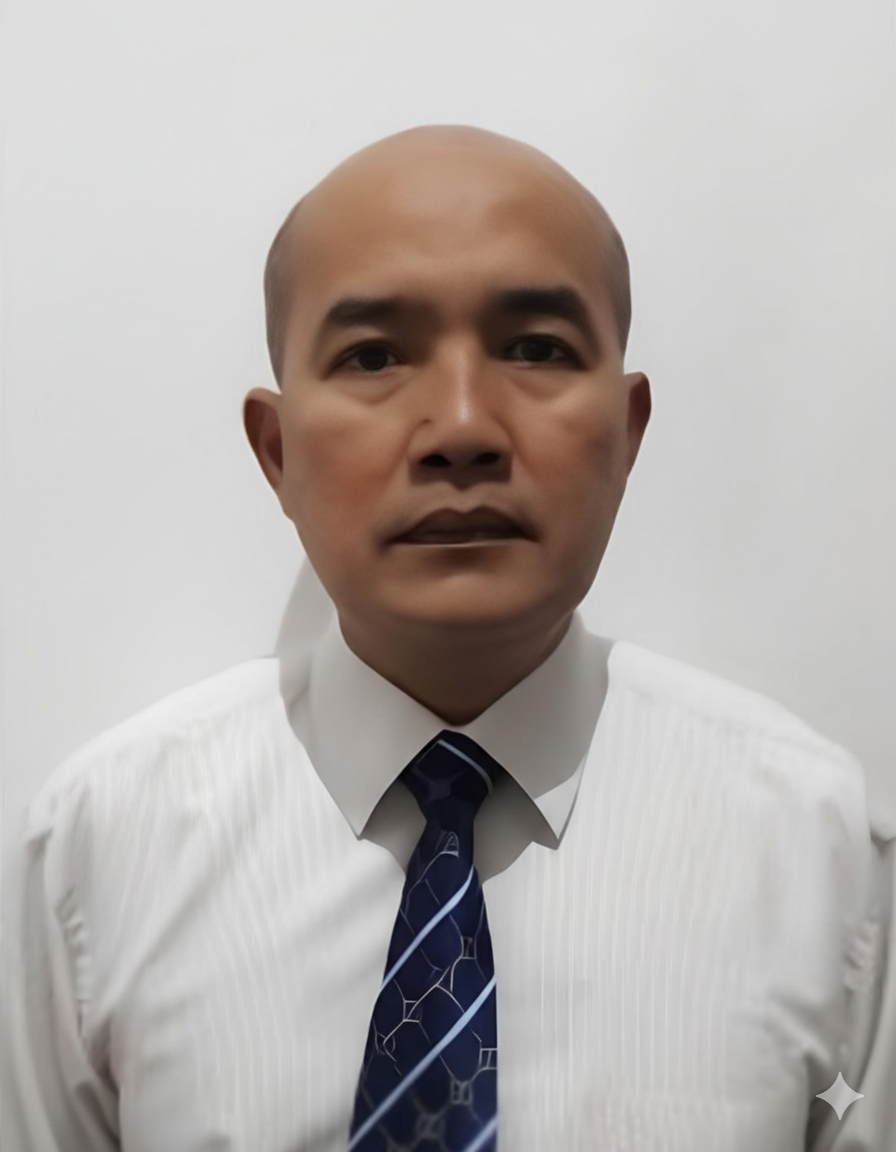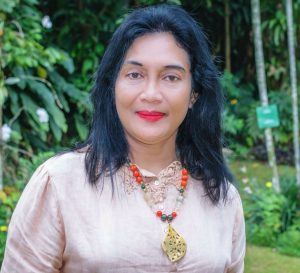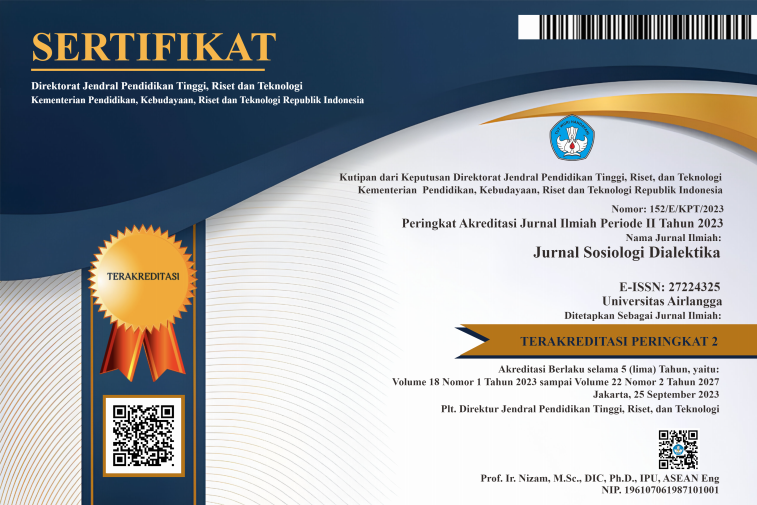Fostering harmony: Key factors in promoting interfaith unity within the Dayak Ngaju Community in Palangka Raya
Downloads
The Palangka Raya City community, initially dominated by the Dayak Ngaju community, now tends to be more diverse. However, this diversity is now disturbed, especially by the issue of religious harmony, where several internal conflicts have occurred between religious communities. Based on this phenomenon, this research examines important elements that can help build unity and relations between religious communities in the Dayak Ngaju community in Palangka Raya. In this research, data collection was carried out through interviews and documentation studies. The study results indicate that six main factors contribute to increasing harmony: local customs and culture, education and counseling, legitimacy and credibility of traditional and religious figures, relations between religious communities and cultures, social and political conditions, and leadership with integrity. These factors complement each other in maintaining a balance between local traditions and the challenges of modernization so that the Dayak Ngaju community can maintain harmony amidst diversity. Collaboration between the government, Damang, and religious figures is the main key to preventing conflict and strengthening social stability. This research contributes to the formulation of national and regional policies related to efforts to increase harmony and mitigate potential conflicts from a socio-cultural perspective.
Abdoeh NM (2022) Tinjauan sosiologi hukum terhadap efektivitas peraturan bersama Menteri Agama dan Menteri Dalam Negeri dalam mewujudkan kerukunan umat beragama di Kota Salatiga. Iqtisad: Reconstruction of Justice and Welfare for Indonesia 9 (2):211. https://doi.org/10.31942/iq.v9i2.6522.
Antlöv H & Cederroth S (2004) Elections in Indonesia: The New Order and Beyond. London: Routledge.
Arrianie L, Lestari P, Meranti M, & Ningrum DP (2024) Political and intercultural communication in determining presidential candidates in the Indonesian Elections 2024. Jurnal Komunikasi: Malaysian Journal of Communication 40 (3):152-155. https://doi.org/10.17576/JKMJC-2024-4003-09.
Avruch K (2022) Culture and Conflict Resolution. In The Palgrave Encyclopedia of Peace and Conflict Studies. New York: Springer International Publishing. 254-259. https://doi.org/10.1007/978-3030-77954-2_67.
Badan Pusat Statistik (2023) Statistik daerah Kota Palangka Raya 2023. Badan Pusat Statistik. [Accessed 4 August 2023]. https://palangkakota.bps.go.id/publication/2023/12/28/8967b5adb801ccaf93744e25/statistik-daerah-kota-palangka-raya-2023.html.
Butt S (2020) Constitutional recognition of “beliefs” in Indonesia. Journal of Law and Religion 35 (3):450-473. https://doi.org/doi:10.1017/jlr.2020.39.
Coe K, Palmer CT, & ElShabazz K (2013) The resolution of conflict: Traditional African ancestors, kinship, and rituals of reconciliation. African Conflict and Peacebuilding Review 3 (2):110-128. https://doi.org/10.2979/africonfpeacrevi.3.2.110.
Dachlan M (2023) Establishing harmony and social awareness in religious diversity. Asian Social Work Journal 8 (3):e00250. https://doi.org/10.47405/aswj.v8i3.250.
Djungan TDL (2021) Nilai budaya manugal bagi pembentukan karakter dalam melestarikan kearifan lokal masyarakat Suku Dayak Ngaju di Kalimantan Tengah. Proceedings Series on Physical & Formal Sciences 2: 319-323. https://doi.org/10.30595/pspfs.v2i.204.
Fatchurahman M & Solikin A (2021) Internalization of huma betang in cultural counselling: Learning perspective. Educational Sciences: Theory and Practice 21 (1):112-118. https://doi.org/10.12738/jestp.2021.1.009.
Friskilia V, Fauzi MZL, Bertho EM, & Santoso YA (2024) Rasionalitas pemilih pemula di Kota Palangka Raya dalam mengikuti proses pemilu presiden dan wakil presiden tahun 2024. Journal Ilmu Sosial, Politik dan Pemerintahan 13 (2):500-510. https://doi.org/10.37304/jispar.v13i2.14700.
Gavrielides T (2018) Routledge International Handbook of Restorative Justice. Abingdon-on-Thames: Taylor & Francis.
Geertz C (1977) The Interpretation of Cultures. New York: Basic Books.
Hakim MZ, Moenta AP, Jamal F, Ilmar A, Ilyas A, & Irwansyah I (2024) Rise and fall of democracy in regional government: From assignment to election. Yuridika 39 (3):329-332. https://doi.org/10.20473/ydk.v39i3.59821.
Hanke E, Scaff L, & Whimster S (2020) The Oxford handbook of Max Weber. In: Hanke E, Scaff L, & Whimster S (ed). Oxford, New York: Oxford University Press. https://doi.org/10.1093/oxfordhb/9780190679545.001.0001.
Herman H, Noor AF, Rusmaniah R, & Mustikaningsih W (2023) Bhinneka tunggal ika in the frame of huma betang’s philosophy. Tunas: Jurnal Pendidikan Guru Sekolah Dasar 9 (1):24-28. https://doi.org/10.33084/tunas.v9i1.6245.
Husein AR (2021) Role of Damang (tribal chief) on domestic violence cases (Study at Palangka Raya City, Indonesia). Journal of Law and Legal Reform 2 (3):365-378. https://doi.org/10.15294/jllr.v2i2.46534.
Iswantoro I (2021) Strategy and management of dispute resolution, land conflicts at the land office of Sleman Regency. Journal of Human Rights, Culture and Legal System 1 (1). https://doi.org/10.53955/jhcls.v1i1.3.
Jeniva I & Tanyid M (2025) The framework of religious moderation: A socio-theological study on the role of religion and culture from Indonesia’s perspective. Social Sciences & Humanities Open 11: 101271. https://doi.org/10.1016/j.ssaho.2024.101271.
Jeong HW (2009) Conflict Management and Resolution: An Introduction. Abingdon-on-Thames: Taylor & Francis.
Karliani E & Triyani T (2021) Strengthening student’s peace-loving attitudes through huma betang value-based general education curriculum. Journal of Human Behavior in the Social Environment 31 (5):539-550. https://doi.org/10.1080/10911359.2020.1783418.
Kementerian Pendidikan, Kebudayaan, Riset dan Teknologi (2022) Pelajar Pancasila. Pusat Penguatan Karakter Kementerian Pendidikan Dasar dan Menengah, 25 September. [Accessed 30 October 2024]. https://cerdasberkarakter.kemdikbud.go.id/profil-pelajar-pancasila/.
Kisak PF (2017) An Overview of Syncretism: The Multicultural Influence on Religion and Culture. Seattle: Createspace Independent Publishing Platform.
Kurniawan A, Triana N, Sari M, Hasibuan NL, & Ramadhona A (2024) Hukum adat dan nilai restoratif: Kontekstualisasi penyelesaian konflik sumbang adat di Jambi. Masalah-Masalah Hukum 53 (2):111-122. https://doi.org/10.14710/mmh.53.2.2024.111-122.
Kurniawaty I, Faiz A, & Purwati P (2022) Strategi penguatan profil pelajar pancasila di sekolah dasar. Edukatif: Jurnal Ilmu Pendidikan 4 (4):5170-5175. https://doi.org/10.31004/edukatif.v4i4.3139.
Latif HA (2024) Buntut pembongkaran portal, pegawai Kemenag dan BPN dipolisikan oleh Ormas TBBR. Kalteng Pos, 14 October. [Accessed 23 March 2025]. https://www.kaltengpos.info/metropolis/2435192110/buntut-pembongkaran-portal-pegawai-kemenag-dan-bpn-dipolisikan-oleh-ormas-tbbr.
Lederach JP (1995) Preparing for Peace: Conflict Transformation Across Cultures. New York: Syracuse University Press.
Lederach JP (1997) Building Peace: Sustainable Reconciliation in Divided Societies. Washington, DC: United States Institute of Peace Press.
Lepsius MR (2016) Max Weber and Institutional Theory. Heidelberg: Springer International Publishing.
Mietzner M (2020) Authoritarian innovations in Indonesia: Electoral narrowing, identity politics and executive illiberalism. Democratization 27 (6):1021-1036. https://doi.org/10.1080/13510347.2019.1704266.
Nasution FA, Ritonga AD, Anshari A, & Indainanto YI (2022) Empowerment through understanding religious harmony in Timbang Deli Urban Village. Abdimas Talenta: Jurnal Pengabdian Kepada Masyarakat 7 (2):592-597. https://doi.org/10.32734/abdimastalenta.v7i2.8714.
Nofandi A, Naim N, & Hutapea RH (2022) The harmony pattern through huma betang culture of the Dayak Communities in Central Kalimantan. Religious: Jurnal Studi Agama-Agama Dan Lintas Budaya 6 (1):39-48. https://doi.org/10.15575/rjsalb.v6i1.13476.
Nollert M (2021) Social cohesion through outside threats and multiple identities: Simmel’s legacy in the analysis of social conflicts. In: Caetano P& Mendes MM (ed). Simmel and Beyond: The Contemporary Relevance of Simmel’s Thought. London: Routledge. 72-89. https://doi.org/10.4324/9781003182139.
Qoumas YC, Hussain RBBM, & Rahim RABA (2024) The dissemination of religious moderation through the policy of the Indonesian Ministry of Religious Affairs. QIJIS (Qudus International Journal of Islamic Studies) 12 (1):147-160. https://doi.org/10.21043/qijis.v12i1.27552.
Riwanto A, Suryaningsih S, & Firmandiaz V (2024) Preventing Electoral Fraud in Indonesia: Protecting the Social Security of Election Management Personnel. Jurnal Media Hukum 31 (1):95-114. https://doi.org/10.18196/jmh.v31i1.19361.
Selvia L & Sunarso S (2020) Interaksi sosial antara Suku Dayak dan Suku Banjar di Kalimantan. Jurnal Antropologi: Isu-Isu Sosial Budaya 22 (2):208. https://doi.org/10.25077/jantro.v22.n2.p208-216.2020.
Singgih EG (2023) Religious moderation as good life: Two responses to the Ministry of Religious affairs’ directive on religious moderation in Indonesia. Exchange 52 (3):220-240. https://doi.org/10.1163/1572543x-bja10038.
Stewart C (1999) Syncretism and its synonyms: Reflections on cultural mixture. Diacritics 29 (3):40-62. https://doi.org/10.1353/dia.1999.0023.
Sugarman D (1987) In the Spirit of Weber: Law, Modernity and” the Peculiarities of the English” (vol 2). Madison: Institute for Legal Studies, University of Wisconsin.
Suswandari S, Armiyati L, & Azid N (2022) Local wisdom of dayak ethnic groups in central kalimantan, Indonesia. ETNOSIA: Jurnal Etnografi Indonesia 7 (1):67-85. https://doi.org/10.31947/etnosia.v7i1.20633.
Swedberg R & Agevall O (2005) The Max Weber Dictionary. Stanford: Stanford Social Sciences.
Treviño AJ & Staubmann H (2021) The Routledge International Handbook of Talcott Parsons Studies. London: Routledge. https://doi.org/10.4324/9780429321139.
Triana L & Liska R (2020) Politik identitas: Apakah identitas akan mempengaruhi popularitas? (Kajian politik identitas dalam Pilkada Kalteng. WACANA: Jurnal Ilmu Sosial dan Ilmu Politik Interdisiplin 7 (2):163-172. https://e-journal.upr.ac.id/index.php/Jwcn/article/view/3218.
Ufie A, Oruh S, & Agustang A (2022) Maintaining social harmony through historical learning based on local wisdom of indigenous peoples in Maluku. Historia: Jurnal Pendidik Dan Peneliti Sejarah 5 (1):27-36. https://doi.org/10.17509/historia.v5i1.39974.
Ukhra A, Hijri YS, & Taufikurrohman I (2021) Isu politik identitas dan dinasti politik dalam kampanye Pilkada serentak tahun 2020. Jurnal Ilmiah Pendidikan Pancasila dan Kewarganegaraan 6 (2):350. https://doi.org/10.17977/um019v6i2p350-361.
Umi F & Ichwayudi B (2022) Religious harmony in the era of globalization: Social interaction of Muslim and Christian religions in Pelang Village, Lamongan. Tribakti: Jurnal Pemikiran Keislaman 33 (1):173-188. https://doi.org/10.33367/tribakti.v33i1.2040.
Usop SR & Rajiani I (2021) Indigenous Indonesian Dayak traditional wisdom in reducing deforestation. Indonesian Journal of Geography 53 (3):310-317. https://doi.org/10.22146/ijg.43546.
Weber M (1968) On Charisma and Institution Building. In: Eisenstadt SN (ed). Chicago: University of Chicago Press.
Wiguna TM, Murhaini AS, & Budiono A (2024) Huma betang-based resolution of mining land conflicts: Belom bahadat legal culture of Bakumpai Dayak Community in Central Kalimantan, Indonesia. Lex Localis - Journal of Local Self-Government 22 (3):47-53. https://doi.org/10.52152/22.3.4765(2024).

This work is licensed under a Creative Commons Attribution-NonCommercial-ShareAlike 4.0 International License.
1. Copyright of this journal is possession of Editorial Board and Journal Manager, by the knowledge of author, whilst the moral right of the publication belongs to the author.
2. Legal formal aspect of journal publication accessibility refers to Creative Commons Attribution-NonCommercial-ShareAlike (CC BY-NC-SA), implies that publication can be used for non-commercial purposes in its original form (cannot be modified).
3. Every publications (printed/electronic) are open access for educational purposes, research, and library. Other that the aims mentioned above, editorial board is not responsible for copyright violation.















